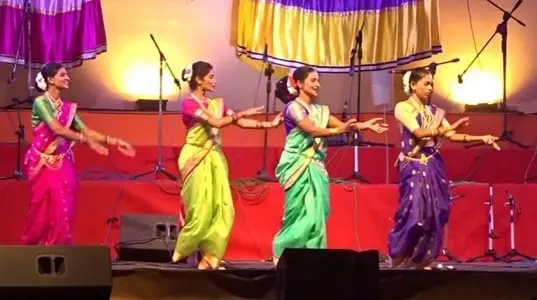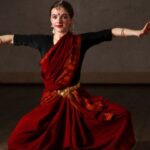By the side of the Arabian Sea, Goa stands as a welcoming state for the tourists around the year. The magnetic attraction of the place is not only limited to the beaches and the beautiful houses, but also the art and culture of the place. Goan dances are the perfect examples of freedom of expression and vibe. The history of the place has offered a depp imprint on the dances. Here we will offer you a brief about it.
Folk Dances of Goa
Dekhni

Traditional Goan dance Dekhnni’s graceful dances and passionate gestures narrate love tales. This elegant dance, primarily performed by women, captivates listeners with its flowing movements and fluid feet. It celebrates love and community in Goan culture. The elegant dance genre’s choreographed sequences express affection. Dancers convey feelings, hopes, and ambitions with beautiful movements and honest expressions. The audience connects to their tale with each action. The harmonious Konkani music of Dekhnni is enchanting. Soulful sounds often accompany dancing, enhancing sensations. These songs’ love and longing lyrics transport listeners to Dekhnni’s beautiful world.
Fugdi
Fugdi, one of Goa’s most famous dances, showcases the state’s vibrant culture. This lively female dance’s round pattern unifies dancers. Fugdi signifies Goan unity via interlocking hands. Its infectious enthusiasm and impressive movement synchronization make Fugdi attractive. Dancers move to Goan folk music. The dancers’ enthusiasm and fast pace make Fugdi appealing. Furdi is part of Goan culture and celebrations, not only entertainment. Fugdi is a religious, wedding, and communal dance. It symbolizes Goan unity and friendliness.
Corredinho
A happy dance, corredinho, depicts how Portuguese culture affected Goan culture. This lovely dance combines Indian and Portuguese elements, featuring a couple’s fast footwork and lively music. Energy from Corredinho is enticing. As they master complex footwork, the dancers beam. The accordion and mandolin provide melody to Corredinho’s pace. Dancers with lavish costumes captivate viewers with their elegant motions and rapid coordination. Corredinho’s vibrant outfits and graceful twirls celebrate Goan culture. Historical significance differentiates Corredinho. Over four centuries of Portuguese domination in Goa are depicted. The adoption of Portuguese ceremonies, music, and dancing transformed Goan culture. Corredinho acknowledges this cultural exchange and Portuguese practices’ continuing impact on Goan heritage.
Mando
A slow, graceful Goan dance, mando, offers stories of love, family, and Goa’s gorgeous environment. Soft, deliberate movements convey profound feelings with couples dancing in a circle. Goan weddings and customs revolve on mando. Mando tells stories via dance. Steps and gestures show love and family. The dance showcases Goa’s culture and beauty. Dancers commemorate their motherland in Mando’s tender embrace. Their beautiful movements capture Goa’s natural beauty. Slow, deliberate dancing interacts with nature, celebrating Goa’s lovely surroundings. Mando’s value transcends art. It permeates Goan culture. The dance is often performed at weddings to symbolize the uniting of two souls and a fresh beginning. At these events, it symbolizes love, family, and Goa’s beauty.
Dhalo
Goa’s famous dhalo dance celebrates harvest. This vibrant, female-only dance mimics agricultural planting and harvesting with powerful, rhythmic gestures. A spirited celebration of Goa’s agricultural history, Dhalo features authentic props and performances. Dhalo’s rich and varied agriculture is unique. Dancers’ bright outfits complement Goa’s lush landscape during harvest season. Sowing and harvesting crops is hard yet rhythmic, and their synchronized actions show agricultural life actively. Dhalo’s sickles and baskets stand out. The dancers use these traditional tools with precision and grace, adding depth and authenticity. Like transporting the harvest, the baskets are gently carried and the sickles rhythmically employed. Detail makes the performance more realistic and transports the audience to a Goan harvest field.
Ghode Modni
The exhilarating Goan “horse dance,” Ghode Modni transports performers and watchers to a mythological world of horses and warriors. Dancers in horse-like costumes display precision footwork to traditional music. Shigmo festival involves this lively dance depicting Goan mythology and history. “Ghode Modni” means a strange dance. Onstage, their outfits make dancers seem like horses. Their exquisite costumes with flowing manes, hooves, and tails demonstrate their dedication to this unique culture. Ghode Modni is defined by the dancers’ intricate footwork and rhythm. Infusing the dance with horse galloping, prancing, and charging, they excel. This lively show and traditional music immerse the audience in Goan folklore.
Tonvamel
Tonvamel, a traditional Goan dance, is a moving commemoration of a birth or family reunion. With intricate movements, exquisite hand motions, and Konkani music, women perform this graceful dance alone. It signifies joy and gladness in Goan culture, permitting social festivities and warm greetings. Tonvamel’s delight and company characterize it. Women do this dance in groups during life events. Tonvamel celebrates family milestones and welcomes newcomers. The intricate choreography is executed with precision and coordination. Expression also involves hand motions. Tonvamel is an emotional celebration because these dances convey energy and profundity.
Conclusion
As you can well imagine, the history and culture of Goa is imbued in the dances. With the fine and rhythmic movements and colorful dresses the dances transport the imagination of the dance lovers by the aid of the music. The heart and soul of Goa is comes up in all its vaigor with these dances.
Santosh Kumar, He is a SEO + Blogger have 12 years of experience in writing tutorial, informative and product reviews topics.
Page Contents

